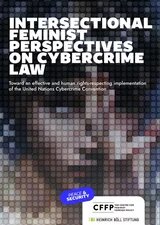Intersectional Feminist Perspectives On Cybercrime Law
As cybercrime evolves, it deepens existing inequalities, disproportionately affecting marginalized groups such as women, LGBTQIA+ individuals, and human rights defenders. While the UN Cybercrime Convention aims to combat transnational cyber threats, its broad scope raises concerns about state overreach and potential misuse against vulnerable communities. This policy briefing examines these risks through an intersectional feminist lens, highlighting the dangers of weaponized cybercrime laws and advocating for a human rights-based approach. Read more to explore key insights, case studies, and policy recommendations.
Product details
Table of contents
1. Introduction
2. The differentiated impacts of cybercrime and cybercrime law
3. An intersectional feminist approach to cybercrime legislation
4. National cybercrime legislation and state overreach
4.1. The need for clear definitions: expansive scopes in national cybercrime laws can lead to unintended consequences
4.2. The need to protect digital (civic and public) spaces and privacy: about state surveillance on the basis of national cybercrime legislation and its silencing effects
4.3. Access to justice, right to due process and right to effective remedy
4.4. Cascading and compounding effects
5. The UN Cybercrime Convention
5.1. UN Cybercrime Convention and gender
5.2. Expansive scope may turn the Convention into a general data access treaty
5.3. Problematic mutual legal assistance and data collection
5.4. Extremism- and terrorism-related offences do not belong in a legally binding cybercrime treaty
5.5. CSAM and NCSII
5.6. Victim support and witness protection
6. The way forward: Recommendations for national governments, UN institutions, and non-governmental actors
7. Bibliography
